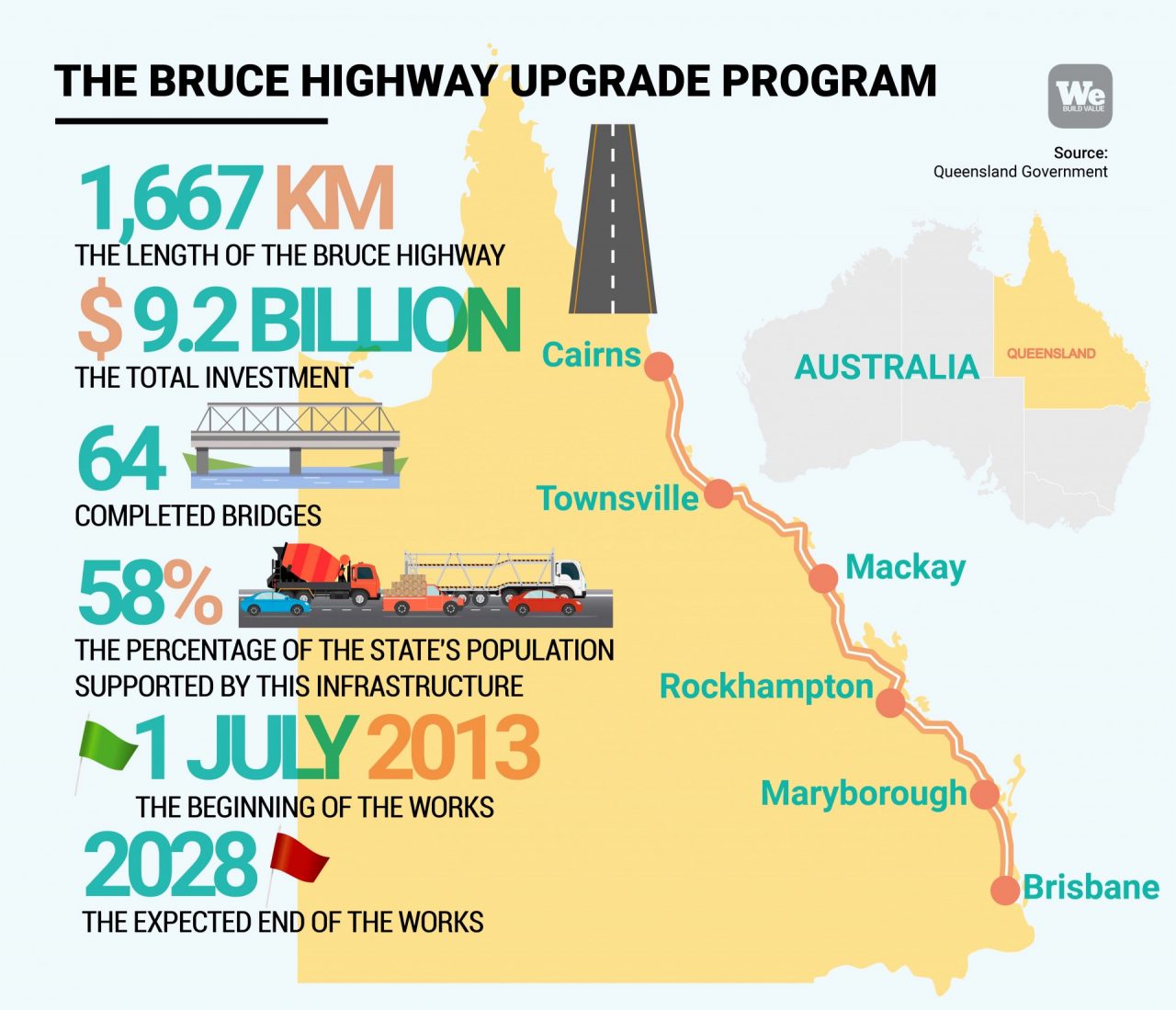A new infrastructure that improves traveler safety, reduces traffic congestion, protects travelers from flood risk, and cuts down travel times between Brisbane, Queensland’s capital, and Cairns, the city world-famous as the starting point for visiting both the Great Barrier Reef and the Daintree Rainforest. That is an ambitious goal that matches the amount of investment in Queensland’s largest road project: the Bruce Highway Upgrade Program.
A gargantuan project that began on July 1, 2013, with the initial intention of completing it within ten years. This target has been revised over time in light of the complexities of a project that effectively overhauls an entire state’s road network. And so, in addition to the A$8.5 billion (US$5.9 billion) allocated at the outset, both the Australian and Queensland federal governments have allocated new funds to the project up to the total figure of A$13 billion (US$9.2 billion), with the goal of completing all works by 2027-2028.
Rebuilding the highway through Queensland
The projected 15 years to the finish date is a reasonable time frame for the scope of a work that will change Queensland’s mobility. The work on the road corridor that runs for 1,677 kilometres (1,046 miles) connecting Brisbane and Cairns involves upgrading the entire route. New connections will be made to other national highways, to 11 ports on the coast, and of course to agricultural and tourist areas.
As of December 2020, 23 works within the overall project had already been completed. These included 64 bridges strategic for the goal of modernising the infrastructure, reducing the need to pass through cities and towns, and to improve traveler safety.
The ultimate goal of this Bruce Highway Upgrade Programme for one of the most important infrastructures in Australia is threefold. On the one hand, the aim is to ensure higher safety standards for travelers on the highway, with new signage, reconstruction of highway intersections and interchanges, and construction of safety barriers to reduce the risk of fatal accidents. Secondly, the project aims to improve the efficiency of the infrastructure by protecting it from floods that affect the region at certain times of the year. New elevated sections of road have been built where flooding generally occurs. The third goal is to turn the infrastructure into an economic driver, a goal that can be achieved by improving the services offered by the highway itself, starting with the rest stops.
A stone's throw from the Great Barrier Reef
Cairns is a small city on Australia’s Northeast coast. With an estimated population of 144,000, it is the fifth most populous city in Queensland and the 14th most populous in Australia. However, despite its small size, it is the fourth most popular tourist destination in Australia, after Sydney, Melbourne and Brisbane because of its proximity to the Great Barrier Reef, but also by the rainforest that surrounds it. That is also why the redevelopment project is focused on Cairns, the destination for sea lovers from around the world. In fact, among the various works planned, a new 3.4-kilometre (2.1-mile) section was built at the southern entrance to Cairns. The work eliminated two railroad crossings, thus reducing traffic at the entrance, as well as providing bike lanes and paths dedicated exclusively to pedestrians. CairnsConnect (as the works carried out in the town are known) also provided for the construction of a new network of roads that would more efficiently connect the highway with the port and with local mobility.
Bruce Highway, the history of a strategic infrastructure
Named after Harry Bruce, the Queensland Infrastructure Minister who backed several important projects in the 1930s, the Bruce Highway is a strategic transportation artery for Queensland. In addition to connecting all coastal centers, the highway supports 58% of the state’s population and is the most important road corridor for commuters and tourists alike, according to the Australian Government’s Department of Transportation. The current infrastructure is the result of a series of road links whose construction dates back to the 1930s, but which over time have undergone numerous reconstruction and upgrades, culminating in the landmark date of December 1986 when National Highway 1, of which the Bruce Highway itself is a part, was officially opened. Despite numerous interventions, the Bruce Highway has always shown a number of structural limitations, mainly related to the climatic characteristics of the area, which is battered by monsoons at certain times of the year. Thus, after the catastrophic floods that hit Queensland between 2010 and 2011, the Australian federal government established a study commission to design a major upgrade of the highway. The result is the Bruce Highway Upgrade Programme.


